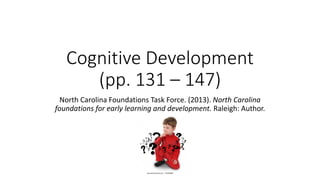
NC Foundations Cognitive Development Goals
- 1. Cognitive Development (pp. 131 – 147) North Carolina Foundations Task Force. (2013). North Carolina foundations for early learning and development. Raleigh: Author.
- 2. Subdomains and Goals • Social Connections (note the crossover into the cognitive domain) • Goal CD-6: Children demonstrate knowledge of relationships and roles within their own families, homes, classrooms, and communities • Goal CD-7: Children recognize that they are members of different groups (e.g., family, preschool class, cultural group) • Goal CD-8: Children identify and demonstrate acceptance of similarities and differences between themselves and others. • Goal CD-9: Children explore concepts connected with their daily experiences in their community.
- 3. Subdomains and Goals (2) • Mathematical Thinking and Expression • Goal CD-10: Children show understanding of numbers and quantities during play and other activities. • Goal CD-11: Children compare, sort, group, organize, and measure objects and create patterns in their everyday environment • Goal CD-12: Children identify and use common shapes and concepts about position during play and other activities • Goal CD-13: Children use mathematical thinking to solve problems in their everyday environment
- 4. Subdomain and Goals (3) • Scientific Exploration and Knowledge • Goal CD-14: Children observe and describe characteristics of living things and the physical world. • Goal CD-15: Children explore the natural world by observing, manipulating objects, asking questions, making predictions, and developing generalizations.
- 5. Social Connections (pp. 131 – 136) • Again, note the interrelatedness of cognitive development and social development • Healthy relationships support cognitive development and later academic and life success • Note the progressive and sequential developmental indicators for each goal within the “social connections” subdomain • Use natural classroom experiences and interactions to “talk about the importance of accepting people who are similar to and different from themselves”
- 6. Strategies for Infants and Toddlers • Help them feel safe and secure by responding to their needs and holding them in ways that support secure attachments • Have diverse and multi-cultural books, materials and activities, including things specifically related to a child’s family. • Note #4 on p. 135. Be discreet and sensitive to the cultures with whom you are working. Ensure positive interactions with all families, no matter your own personal biases!! • Help children play together and support children with disabilities, who speak different languages, or who may otherwise need help interacting positively with adults and other children.
- 7. Strategies for Preschoolers - Social • Provide props, equipment, materials, literature, music and activities that reflect children’s families and community in addition to global diversity • Help children develop social skills that support positive relationships and interactions with others • Provide activities that help children recognize similarities and differences • Model and practice problem-solving strategies in natural and planned experiences • Participate in service activities
- 8. Mathematical Thinking and Expression (pp. 137-143) • Note the progressive Developmental Indicators and the interrelatedness of mathematical concepts in everyday explorations and activities with young children • Understand and plan for concept development as it relates to mathematical thinking and expression: numbers, seriation, one-to- one correspondence, patterns, classification, spatial sense, conservation, etc. • Numbers and math concepts are best learned in naturally occurring circumstances as opposed through direct instruction • NO WORKSHEETS!
- 9. Strategies for Infants and Toddlers • Use language to talk about and elaborate on math concepts • Provide toys and materials that promote sizing, one-to-one correspondence, categorizing • Play games and sing songs that involve numbers and counting • Read books that involve math concepts (daily schedules, numbers, spatial concepts such as “in the box” and “under the table”) • Call attention to and talk about patterns in nature. Play with natural materials • Use sand and water play with many containers of various sizes • Count within the normal context of daily activities – 4 cups at snack
- 10. Strategies for Preschoolers • Provide a variety of toys and materials in all centers that support development of mathematical thinking while promoting development in all developmental domains • Ask open-ended questions to help children analyze and problem solve in everyday contexts and play • Use literacy (books, songs, finger plays, etc.) that promote math concepts • Count, identify shapes and geometric figures, use schedules, measure and weigh throughout the day through play and classroom routines.
- 11. Scientific Exploration and Knowledge (pp. 144 – 147) • Progressive Developmental Indicators are provided for each of the goals. • Scientific exploration and knowledge is enhance through multi- sensory experiences • Children with disabilities may need additional supports so that they can fully experience and explore • Motivation, curiosity, and wonder must be encouraged. • Help children observe, describe, collect, explain, predict, question, compare, problem-solve, etc. • Encourage responsibility through care of living things
- 12. Strategies for Infants and Toddlers • Play with toys that encourage cause and effect activities • Observe children’s interests and use language to explore their interests • Allow children to explore, including putting safe toys and objects in their mouths, explore various textures and surfaces, look at moving and patterned objects, and other multi-sensory exploration • Use books, pictures, games that help children identify and learn about the world around them
- 13. Strategies for Preschoolers • Use the scientific method within the natural context of exploring topics of interest: observe, question, predict, experiment, draw conclusions, share results. • Help children ask questions, problem-solve, record their thinking processes • Mental model thinking processes that encourage curiosity and wonder • Provide equipment, tools, materials that encourage exploration and can be used in a variety of ways. • Provide opportunities to explore natural materials in natural contexts.